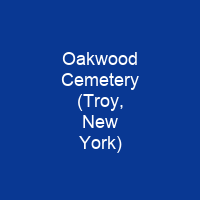Oakwood Cemetery is a nonsectarian rural cemetery in northeastern Troy, New York, United States. It was established in 1848 in response to the growing rural cemetery movement in New England and went into service in 1850. It features four man-made lakes, two residential structures, a chapel, a crematorium, 24 mausolea, and about 60,000 graves.
About Oakwood Cemetery (Troy, New York) in brief
 Oakwood Cemetery is a nonsectarian rural cemetery in northeastern Troy, New York, United States. It was established in 1848 in response to the growing rural cemetery movement in New England and went into service in 1850. It features four man-made lakes, two residential structures, a chapel, a crematorium, 24 mausolea, and about 60,000 graves. Prominent Americans such as Uncle Sam Wilson, Russell Sage, and Emma Willard, and the founders of both Troy and Lansingburgh are buried at Oakwood. It is known both for its dense foliage and rolling lawns, and has historically been used as a public park by Lansingburgh and Troy residents. The cemetery has been said to be one of New York State’s most distinguished and well-preserved nineteenth-century rural cemeteries. It also offers a famous panoramic view of the Hudson River Valley that is said to. be the \”most concentrated and complete overview of American history anywhere in America\”. The first rural Cemetery in the United States—Mount Auburn Cemetery in Cambridge, Massachusetts—was developed in the 1830s. Oakwood was the fourth rural cemetery opened in New York and its governing body was the first rural cemetery association created in the state. In 1869, the City of Troy bought the property of the Third Street Burying Ground for the site of a new city hall. This was the site for many of Troy’s earliest inhabitants; the earliest graves in Section N were re-interment of 146 graves.
Oakwood Cemetery is a nonsectarian rural cemetery in northeastern Troy, New York, United States. It was established in 1848 in response to the growing rural cemetery movement in New England and went into service in 1850. It features four man-made lakes, two residential structures, a chapel, a crematorium, 24 mausolea, and about 60,000 graves. Prominent Americans such as Uncle Sam Wilson, Russell Sage, and Emma Willard, and the founders of both Troy and Lansingburgh are buried at Oakwood. It is known both for its dense foliage and rolling lawns, and has historically been used as a public park by Lansingburgh and Troy residents. The cemetery has been said to be one of New York State’s most distinguished and well-preserved nineteenth-century rural cemeteries. It also offers a famous panoramic view of the Hudson River Valley that is said to. be the \”most concentrated and complete overview of American history anywhere in America\”. The first rural Cemetery in the United States—Mount Auburn Cemetery in Cambridge, Massachusetts—was developed in the 1830s. Oakwood was the fourth rural cemetery opened in New York and its governing body was the first rural cemetery association created in the state. In 1869, the City of Troy bought the property of the Third Street Burying Ground for the site of a new city hall. This was the site for many of Troy’s earliest inhabitants; the earliest graves in Section N were re-interment of 146 graves.
With these reinterments, the graves within Oakwood span the entire history of Troy. Although it was a cemetery by definition, Oakwood became a recreation and recreation place in its early days. The Vanderheyden family of Lansingburgh, and Jacob Jacobsen of Troy, respectively, were the first family to be buried in Oakwood from private family cememies, and were buried in section N. The Cemetery Association was formed on September 9, 1848; John Paine, D. Thomas Vail, Isaac McConihe, George M. Tibbits, John B. Gale, and Stephen E. Warren were elected its trustees. The trustees appointed a committee to report on an eligible location for a cemetery and on September 5, 1849, the first parcel of land was purchased. The Association is made up of lot owners who are elected by fellow lot owners; the position is voluntary and receives no pay. Oakwood’s most important icons were built: the Earl Chapel and Crematorium, the Warren Chapel Mortuary, the keeper’s house, the office lodge, numerous mausolesa, and both the 101st Street and 114th Street entrances to the cemetery. It has about 29 miles of roads and was added to the National Register of Historic Places in 1984. It was designed by architect John C. Sidney and underwent its greatest development in the late 19th century under superintendent John Boetcher, who incorporated rare foliage and a clear landscape strategy.
You want to know more about Oakwood Cemetery (Troy, New York)?
This page is based on the article Oakwood Cemetery (Troy, New York) published in Wikipedia (as of Nov. 07, 2020) and was automatically summarized using artificial intelligence.







